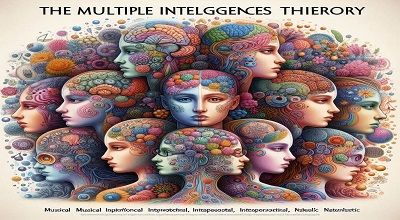Multiple Intelligences Theory
The Multiple Intelligences Theory is a cognitive theory developed by Howard Gardner. A psychologist and professor of education at Harvard University. Gardner introduced this theory in his 1983 book, “Frames of Mind: The Theory of Multiple Intelligences.” The theory challenges the traditional view of intelligence, which primarily focuses on a single. General measure of cognitive ability, often measured by IQ tests.
Instead, Gardner proposed that there are multiple, distinct types of intelligence. Each represents a different way in which individuals can excel or demonstrate their intellectual abilities. Gardner initially identified seven intelligences in his theory. And later expanded the list to include an eighth.
The multiple intelligences are:
- Linguistic Intelligence: This type of intelligence involves proficiency in language, including reading, writing, speaking, and listening. People with linguistic intelligence are skilled at using words to convey ideas effectively.
- Logical-Mathematical Intelligence: This intelligence relates to logical reasoning and problem-solving particularly in mathematical and scientific contexts. People with this intelligence excel in analytical thinking and problem-solving.
- Spatial Intelligence: Spatial intelligence refers to the ability to perceive the world in three dimensions and manipulate mental images. People with this intelligence often have a strong sense of direction and an aptitude for visual arts and design.
- Musical Intelligence: Musical intelligence involves sensitivity to rhythm, pitch, melody, and tone. Individuals with this intelligence may excel in playing musical instruments, composing music, or understanding and appreciating complex musical patterns.
More here…
- Bodily-Kinesthetic Intelligence: This type of intelligence relates to physical coordination and dexterity. People with bodily-kinesthetic intelligence excel in activities. That requires precise control of body movements, such as sports, dance, or crafts.
- Interpersonal Intelligence: Interpersonal intelligence is the ability to understand and relate effectively to others. People with this intelligence are skilled at social interaction, empathy, and communication.
- Intrapersonal Intelligence: Intrapersonal intelligence involves self-awareness and an understanding of one’s own emotions, motivations, and goals. Individuals with this intelligence are introspective and have a deep understanding of themselves.
- Naturalistic Intelligence: This intelligence was added later by Gardner and involves an affinity for understanding. And categorizing the natural world, including plants, animals, and ecological systems.
Importance of Multiple Intelligences Theory
The Multiple Intelligences Theory was developed by Howard Gardner. Has been influential in the fields of education and psychology for several reasons. While it has its critics and is not universally accepted.
There are several key points that highlight its importance and contributions:
- Recognition of Diversity: The theory acknowledges that people have diverse intellectual strengths and talents. It values a broader range of abilities beyond the traditional notion of intelligence measured by IQ tests. This recognition promotes inclusivity and encourages a more holistic understanding of human potential.
- Tailored Education: The theory has had a significant impact on educational practices. It encourages educators to recognize and accommodate different learning styles and preferences, allowing for more personalized and effective teaching. Teachers can design lessons that appeal to various intelligences, increasing student engagement and understanding.
- Enhanced Self-Understanding: Gardner’s theory promotes self-awareness by encouraging individuals to identify their own strengths and areas of intelligence. This can lead to greater self-confidence and motivation to pursue areas. In which they excel, potentially improving personal and career satisfaction.
- Broadened Assessment Methods: The theory has influenced the development of alternative assessment methods. Rather than relying solely on traditional standardized tests. Educators and psychologists have devised more diverse ways of evaluating intelligence. Such as performance-based assessments, portfolios, and project-based learning.
- Cultural and Individual Sensitivity: Recognizing multiple intelligences can help educators and society. As a whole be more culturally and individually sensitive. Different cultures and individuals may place greater emphasis on specific intelligence, and understanding. These variations can lead to more culturally relevant and equitable education.
Extra Key Points…
- Encouragement of Non-Academic Skills: Gardner’s theory emphasizes that intelligence is not limited to academic abilities. This can lead to a greater appreciation of skills that are essential for success in many aspects of life. Such as social and emotional intelligence, creativity, and practical skills.
- Motivation and Engagement: By recognizing and valuing various intelligences, educators can help students find their passions and strengths. Which can lead to increased motivation and enthusiasm for learning. Students are more likely to engage with subjects that align with their individual strengths.
- Application in Different Contexts: The theory’s principles can be applied beyond education to fields like counseling, career development, and team building. Understanding one’s intelligence can inform career choices and help individuals work more effectively in teams by leveraging diverse strengths.
- Innovative Problem-Solving: In a world where complex, multifaceted problems often require creative solutions. The idea that individuals have diverse ways of thinking and problem-solving can be invaluable. A team with members possessing a variety of intelligence can tackle challenges from multiple angles.
Summary
It’s important to note that Gardner’s theory does not imply that people have only one of these intelligences. Most individuals have a combination of several intelligences in varying degrees. The theory has been influential in the field of education. It suggests that teaching and assessment should be tailored to recognize and nurture these diverse intelligences. Rather than relying solely on traditional standardized testing. However, it’s also worth noting that the theory has been subject to criticism and debate within the academic community.
The Multiple Intelligences Theory has made significant contributions to education and human understanding. It’s important to note that it is not without criticism. Some critics argue that the concept of “intelligence” can be too broad and that it lacks empirical support. Nevertheless, it remains a valuable framework for thinking about the diversity of human abilities and learning styles. It continues to shape educational practices and discussions about intelligence.
